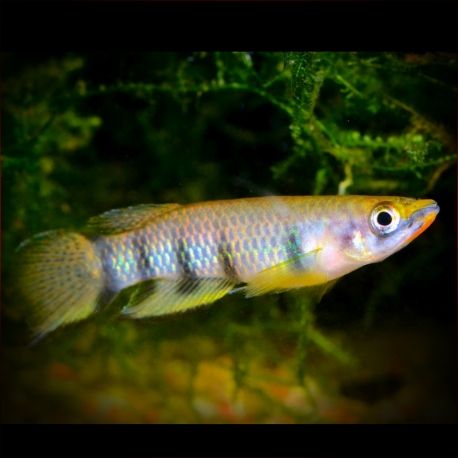More info
Datasheet
| Minimum Tank Size | 60 litres / 15.85 US gallons |
| Maximum Size | 4.5cm / 1.77inches |
| Temperature | 20°C / 68.00°F - 30°C / 86.00°F |
| Hardness | 1.01dgH / 18ppm - 12.05dgH / 215ppm |
| pH | 5.0-7.0 |
General Description
Epiplatys Dageti, commonly known as the Red-Chinned Panchax, is a species of aplocheiloid toothcarps classified under the order Cyprinodontiformes. This fish, known for its peaceful nature, is an ideal addition to a well-chosen community aquarium. It can coexist with similarly-sized characids, cyprinids, anabantoids, callichthyids, loricariids, and certain cichlids due to its upper water column preference. Reaching a maximum size of 4.5cm, the Red-Chinned Panchax is recognized for its red-throated form, with a history dating back to its first export from Monrovia, Liberia in 1908.
Aquarium Setup
The Red-Chinned Panchax thrives in a heavily planted or natural-style aquarium environment with a sandy substrate, driftwood roots, and branches. Adding dried leaf litter provides a natural setting and microbe colonies for fry nourishment. The species favors dim lighting and benefits from aquatic plants like Microsorum, Taxiphyllum, or Anubias spp., along with floating vegetation such as Ceratopteris spp.
Behaviour
This species is gregarious and exhibits more interesting behavior when kept in groups of six or more. It is peaceful with other species and shares a habitat with various freshwater fish families, making it compatible in community tanks.
Feeding and Diet
The Red-Chinned Panchax is a predator primarily feeding on terrestrial and aquatic invertebrates and zooplankton. In captivity, it accepts dried foods but should also be offered small live and frozen prey like Artemia nauplii, Daphnia, Moina, grindal worms, and small insects such as crickets or Drosophila fruit flies.
Reproduction & Dimorphism
Breeding this species is relatively easy. Optimal breeding conditions include a mature, well-decorated tank with suitable surfaces for egg deposition. Males are more colorful, larger, and possess extended fins, notably the lower caudal-fin lobe, which grows with age.
Habitat and Distribution
Epiplatys Dageti is commonly found in the swampy areas of the coastal savanna in regions such as southwestern Ghana, southern Côte d’Ivoire, and southern Liberia. It shares its habitat with congeners like Epiplatys bifasciatus, Epiplatys etzeli, and Aplocheilichthys rancureli. The fish is typically found in freshwater, with some populations existing in brackish conditions.

